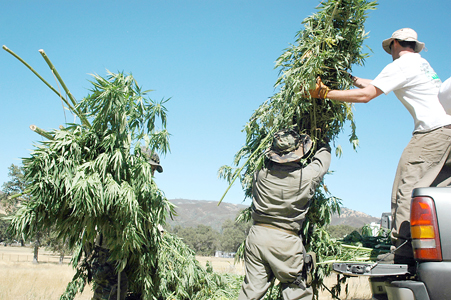Illegal plants in isolated areas of San Benito
San Benito County ranchers have been plagued by a new pest they
can’t combat with traditional methods. The pest moves in, wreaks
havoc on their land by destroying natural resources, kills wildlife
and often endangers the lives of ranchers and their families.
The pest is not an invasive weed, a new weevil or an insect. It
is marijuana and the farmers who grow it. The problem is more
common than it might seem. While it is a situation few ranchers
talk about, they all agree it causes major problems.
Illegal plants in isolated areas of San Benito
San Benito County ranchers have been plagued by a new pest they can’t combat with traditional methods. The pest moves in, wreaks havoc on their land by destroying natural resources, kills wildlife and often endangers the lives of ranchers and their families.
The pest is not an invasive weed, a new weevil or an insect. It is marijuana and the farmers who grow it. The problem is more common than it might seem. While it is a situation few ranchers talk about, they all agree it causes major problems.
“What happens is that these people [growers] come on to Bureau of Land Management land and onto private property and they play havoc with the property,”said a former law enforcement agent, who requested to remain anonymous. “They cut down trees. They dam up waterways and they bring in fertilizers and sprays that are harmful to the environment.”
Often the growers are armed and dangerous. Two years ago there was a shooting where one person died. In a separate incident in Los Gatos a law enforcement officer was shot, the agent said.
“It’s getting to be an epidemic in San Benito County,” the former agent said. “Nobody has been hurt so far. Hopefully it stays that way.”
Growers sneak onto ranches often under the blanket of nightfall. They hike miles over grueling and treacherous terrain into canyons that are very isolated.
A lot of growers use bicycles to carry supplies such as propane tanks and bags of concrete they use to dam up rivers.
The growers kill wildlife that get too close to their crops, whether it’s deer or boars. When animals eat the marijuana, the growers kill the animals and leave their carcasses scattered throughout the property.
State drug enforcement agencies try to close down as many of these illegal operations as they can, but they are hindered by the amount of space they occupy and the inventiveness of the growers.
Part of the problem with locating the growers is that when law enforcement agents discover a pot grove the growers often have hideaways where they can conceal themselves or run so as not to get caught.
“The areas where these people tend to trespass cover a lot of property,” said United Narcotics Enforcement Team Taskforce Commander Mark Colla. “Then to see them on a [fly over] when they’re hiding under canopies is tough. What we tend to notice is that they tend to camouflage themselves and their equipment, to the point where if they are using 5-pound propane tanks they even spray-paint those.”
The growers even go as far as to conceal their tents with surrounding shrubbery, so they can blend with their surroundings. Sometimes law enforcement gets lucky and they are able to arrest suspects when they are sighted, Colla said. Other times growers run and hide. Often they have hideouts where they can stay for days if need be.
The UNET choppers don’t patrol ranches looking for growers unless they get a complaint from ranchers, hunters or people who use All-Terrain Vehicles in the areas.
The operations are not cheap; the people that operate these pot farms have a lot of money invested in them and are not anxious to lose that investment. They arm their employees and often set traps to keep unsuspecting hunters away.
The former agent frequently finds gun shells near the pot groves he encounters when he’s out hunting, so he knows these people are arming themselves.
He’s even heard that some of the Mexican drug cartels that operate pot farms hire Mexican Indians that are use to mountainous terrain to harvest it because they know the environment.
“A lot of these ranches are family-operated and the ranchers have wives and children that help with the herds. If they ride through one of these groves they could encounter problems,” the former agent said.
One year he discovered a grove and ended up carrying out 40 pounds of buds on his back, which he turned over to law enforcement officials, the former agent said.
Colla estimated that UNET busted seven large gardens and eradicated 31,000 plants in 2005. He couldn’t specify the amount found in San Benito County. One plant produces about one pound of marijuana, so UNET confiscated and destroyed 15 tons of marijuana. They also arrested eight people and seized 12 firearms.
In San Benito County three gardens with 10,000 plants have been located this year, according to the former agent, and there are sure to be more undiscovered plants.
Patrick O’Donnell can be reached at po*******@**********ws.com










